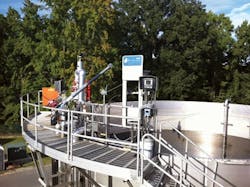Deammonification: Chemical-Free Cost Savings
About the author: Chandler Johnson is chief technology officer of World Water Works. Johnson can be reached at [email protected].
Seeking a sustainable wastewater treatment solution that also provides significant cost savings can be a daunting task. Charles Bott, director of water technology and research for Virginia-based wastewater treatment utility Hampton Roads Sanitation District (HRSD), was familiar with this scenario when in search of a product solution outside of traditional technology. He approached World Water Works, a designer and manufacturer of wastewater treatment solutions, about working together on HRSD’s York River Treatment Plant. Forming a public-private partnership, the two companies joined forces to successfully install the DEMON sidestream deammonification system, a full-scale centrifuge centrate treatment process.
An Unconventional Method
This biological process replaces conventional nitrogen removal methods with a two-step single-stage process that provides benefits while removing nitrogen from wastewater containing high ammonia concentrations. In addition to providing up to 90% ammonia and 80% total inorganic nitrogen removal while reducing a facility’s energy requirements and carbon footprint, this process significantly decreases the need for costly chemicals such as methanol and alkali.
The process had been applied at approximately 30 plants in Europe, but it had not been implemented anywhere else on a full scale.
HRSD is a regional wastewater treatment utility in southeast Virginia that serves 17 localities and operates 13 wastewater treatment plants, serving more than 1.6 million people with a combined capacity of 249 million gal per day (mgd). Since its founding 75 years ago, HRSD has been dedicated to innovation in wastewater treatment, pioneering new technologies including the state’s first municipal water reuse project in 2002.
“We initially approached the DEMON project from the perspective of cost management,” Bott said. “Responding to new regulations on wastewater quality, we had added denitrification filters to the York River plant.”
This upgrade was undertaken with the expectation that the plant would be expanded from 15 to 30 mgd, but when that expansion was delayed, HRSD was left with a partial 15-mgd and partial 30-mgd plant that was expensive to operate from a chemical standpoint. “Finding the right solution was crucial,” Bott said.
Saving on Energy
Nitrogen removal typically has required a large amount of energy, a carbon source (usually methanol) and often other relevant chemicals. These types of systems use a multi-step nitrification/denitrification process.
The first two steps require relatively high amounts of dissolved oxygen supplied by blowers. The last two require additional carbon sources (usually methanol) and produce a large amount of sludge.
Developed and patented by researchers at the University of Innsbruck in Austria, the technology involves a single-stage, two-step process. The method provides effective nitrogen removal that is chemical free and promotes carbon fixation. First, ammonia-oxidizing bacteria convert about half of the ammonia to nitrite. Then, a second class of bacteria (anammox) converts the remaining ammonia with this nitrite to produce nitrogen gas. Anammox bacteria work in an anaerobic environment, so the second step requires no dissolved oxygen and therefore no extra energy. It also requires neither methanol nor other costly chemicals.
Overall, the technology eliminates the need for chemicals, reducing sludge-handling volumes by up to 90%, and reducing nitrogen removal energy requirements by up to 60%.
“When it comes down to it, our chemical costs at the York River Treatment Plant were so expensive that we had no other choice but to find a chemical-free process,” Bott said. “The DEMON technology was the ideal solution to for our growing nutrient removal needs.”
Because shipping the seed bacteria overseas would be both expensive and logistically difficult, the startup of the HRSD project presented some challenges. But World Water Works had relationships with the facilities in Europe and already had developed a strong infrastructure and detailed methods to supply anammox to the U.S.
“Given the anatomy of the plant itself, the relatively simple and inexpensive project took less than four months,” Bott said. “Successful operation has continued since.”
Maintenance Benefits
Since installation of the technology, the York River Treatment Plant has gone beyond HRSD’s goal of finding a more cost-effective and sustainable wastewater treatment approach. The reduction of methanol volume and other chemicals used at the site will help save the facility about $200,000 per year.
In addition to the chemical savings, after a brief period of orientation, HRSD staff found that the system also is low maintenance and requires a limited amount of operational oversight. The biomass separation device keeps the bacteria levels stable and the automated controls make the system nearly worry‐free for staff.
Download: Here
